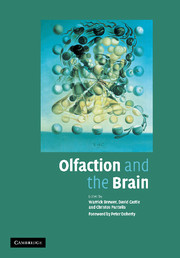Book contents
- Frontmatter
- Contents
- Foreword
- Preface
- List of Contributors
- Section I Neurology, Neurophysiology and Neuropsychology: Olfactory Clues to Brain Development and Disorder
- 1 Structure and Function of the Olfactory System
- 2 Olfaction and the Temporal Lobes
- 3 Role of the Insula in Smell and Disgust
- 4 Olfaction and Memory
- 5 Olfactory Neurogenesis: A Window on Brain Development
- 6 Olfactory Processing and Brain Maturation
- 7 Probes of Behaviour Regulation: Olfactory Models in Addiction
- Section II Social Functioning: Role of Evolution, Genetics and Gender
- Section III Assessment and Disorders of Olfaction
- Index
- Plate section
- References
7 - Probes of Behaviour Regulation: Olfactory Models in Addiction
from Section I - Neurology, Neurophysiology and Neuropsychology: Olfactory Clues to Brain Development and Disorder
Published online by Cambridge University Press: 17 August 2009
- Frontmatter
- Contents
- Foreword
- Preface
- List of Contributors
- Section I Neurology, Neurophysiology and Neuropsychology: Olfactory Clues to Brain Development and Disorder
- 1 Structure and Function of the Olfactory System
- 2 Olfaction and the Temporal Lobes
- 3 Role of the Insula in Smell and Disgust
- 4 Olfaction and Memory
- 5 Olfactory Neurogenesis: A Window on Brain Development
- 6 Olfactory Processing and Brain Maturation
- 7 Probes of Behaviour Regulation: Olfactory Models in Addiction
- Section II Social Functioning: Role of Evolution, Genetics and Gender
- Section III Assessment and Disorders of Olfaction
- Index
- Plate section
- References
Summary
The utility of olfactory probes for understanding disorders involving orbitofrontal compromise has been outlined in Chapter 6. In this chapter, we discuss how such investigations may also be applied to addiction, where current neurobiological models implicate dysfunction within the orbitofrontal cortex (OFC) as a core underlying feature (Lubman et al., 2004). Hence, the focus of the chapter is not on olfaction per se, but more broadly upon compromise of OFC structure and function. The aim is to model one example of how olfactory testing could be applied to investigations of OFC function and related behavioural outcomes. Specifically, we discuss how abnormalities within the OFC and associated limbic pathways may perpetuate substance use disorders (SUD), as well as having a potential causal role in the development of SUD in at-risk youth. The utility of olfaction in mapping adolescent prefrontal development is also described, with particular reference to impulse control, disinhibition, compulsion and other aspects of decision-making that are mediated by orbitofrontal processes.
Drug use in young people
Adolescence is a period of significant change, encompassing the transition from total dependence on parents to relative independence. To navigate this journey successfully, the young person must develop a number of core skills necessary for adulthood, as well as negotiate a series of emotional and social hurdles. Whilst several characteristic adolescent behaviours (such as increased risk-taking, novelty-seeking and peer-directed social interactions) are frequently blamed on modern youth culture, researchers now recognise that these behaviours are also prominent in other adolescent mammals.
Keywords
- Type
- Chapter
- Information
- Olfaction and the Brain , pp. 119 - 132Publisher: Cambridge University PressPrint publication year: 2006



